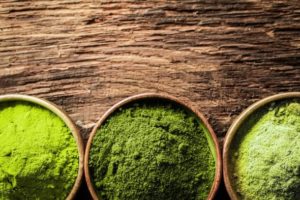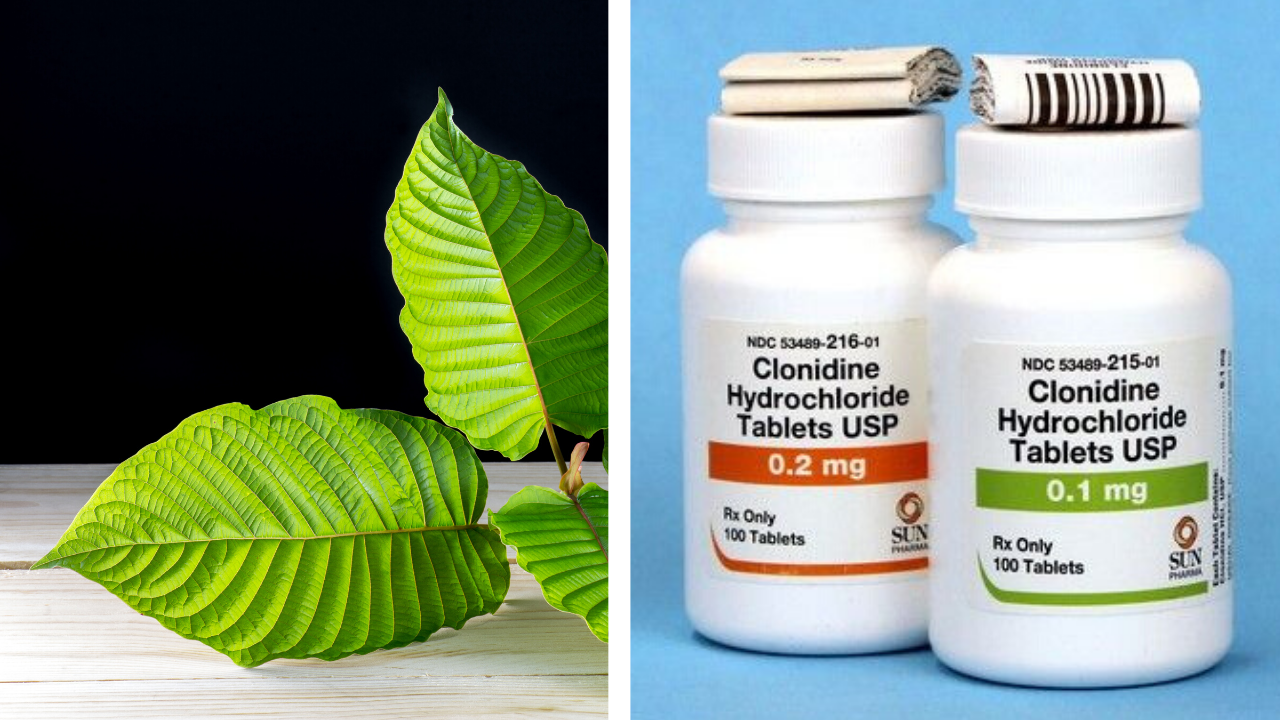In this article, you’re going to learn the differences between Kratom and clonidine, and how to use Kratom and clonidine together in a way that is safe and effective.
These are two substances (the natural Kratom and pharmaceutical clonidine) that have helped countless individuals treat issues like opiate addiction and anxiety to name a couple.
To start things off, I’ll first provide you with brief overviews on Kratom and clonidine.
After that, I’ll discuss the similarities and differences between Kratom and clonidine.
Next, you’ll learn about the Kratom/clonidine combination and how this synergistic duo makes you feel. Then, I’ll add a section with a step-by-step plan for you to use Kratom and clonidine in a manner that is both safe and effective.
Okay, I hope you’re ready to learn some really awesome facts on the science of these two substances!
And without further ado, let’s begin…starting with a brief overview of the controversial Kratom plant…
Table of Contents
- 1 Kratom Overview
- 2 Kratom Risks and Effects
- 3 Biochemical Uniqueness and Kratom
- 4 My First Kratom Experience
- 5 Clonidine Overview
- 6 Clonidine for Opiate Withdrawal
- 7 Clonidine Dependence and Addiction
- 8 Kratom and Clonidine Similarities and Differences
- 9 Effects from Using Kratom and Clonidine Together
- 10 Where to Get Kratom
- 11 How To Use Kratom and Clonidine Together
Kratom Overview
Kratom is an evergreen tree native to Southeast Asia and is a member of the coffee family. Currently, kratom is not regulated by the Drug Enforcement Agency in the United States (making it legal). However, some states have passed laws banning kratom, and it seems like more and more states are banning it or trying to ban it lately.
Despite common misconceptions, Kratom is NOT AN OPIATE.
Kratom, simply put, is an opioid-agonist.
Once a person takes a dose of Kratom, the drug binds to the same opioid receptors in the brain and other parts of the body that opiates bind to, and as a result, leads to effects that feel very similar (though not identical) to opiate drugs.

Mitragynine
Mitragynine, the major alkaloid in Kratom, is a partial opioid agonist producing similar effects to morphine. An interesting minor alkaloid of kratom, 7-hyrdoxymitragynine, has been reported to be more potent than morphine.
Both kratom alkaloids activate supraspinal mu- and delta-opioid receptors, which is the main reason the plant alleviates pain and opiate withdrawal symptoms/cravings so well.
To sum things up, Kratom is not an opiate, however, it binds to the same opioid receptors that opiate drugs bind to. Thus, Kratom is a legal plant that can be used as a natural alternative to prescription or illicit opiates.
Kratom Risks and Effects
I will warn you with a good dose of caution, however, that many individuals are addicted to Kratom. If you take too much for too long, it can even cause a horrible withdrawal syndrome very similar to opiate withdrawal.
People can develop addictions to Kratom because the effects can be quite nice, and though I’ve never become addicted to it while testing different strains and dosages, I can see why so many people abuse it.
Kratom effects include the following:
- Euphoria
- Pain Relief
- Sedation
- Mood-Enhancement
- Mental Stimulation
Note: The Kratom effects vary depending on the strain and dosage used. For instance, lower dosages in the 2-6 gram range could produce stimulating effects, while higher dosages from 7-10 grams or more can lead to more pain relief and sedation.
*Furthermore, the red Kratom strains tend to be the most sedating, while the white strains are typically more stimulating. The green strains are typically not as stimulating as white strains, and not as sedating as red ones, and fall somewhere in the middle of the two.

Biochemical Uniqueness and Kratom
There are many different strains of Kratom to choose from. Kratom has become extremely popular, and there’s an abundance of different strains available online and in smoke shops. As I previously mentioned, different strains have different effects.
Along with this, each human being has their own individual biochemical makeup.
Thus, the same Kratom strain and dosage might make one person feel ABSOLUTELY AMAZING, while it could make another person sick to their stomach. There really is no way to know how you will respond to a particular strain or dosage until you try it.
My First Kratom Experience
After two years of being fascinated with the Kratom plant, I finally gained the courage to try it from a strictly investigative perspective.
I wasn’t using Kratom for medicinal or recreational purposes. I simply wanted to feel the effects of the plant before I wrote an article on how to use kratom for opiate withdrawal. I had been nervous about trying Kratom for some time due to it’s potential to become habit-forming over prolonged use.
But I had ultimate faith in my high level of self-discipline, so I decided to try Kratom for the first time. I ended up really enjoying the mild buzz, which felt a lot like taking hydrocodone, though not exactly.
Relaxing on the couch hadn’t been that much fun in years.
Clonidine Overview
Clonidine is a blood pressure (hypertension) medication that belongs to a class of drugs known as central alpha agonists. According to the American Heart Association:
Central alpha agonists are drugs that lower heart rate and reduce blood pressure. They work by preventing the brain from sending signals from the nervous system to speed up the heart rate and narrow the blood vessels. As a result, the heart doesn’t pump as hard and blood flows more easily through blood vessels.”
Clonidine is also classified as a sympatholytic drug, which is a medication that inhibits the postganglionic functioning of the sympathetic nervous system (SNS). The SNS is part of the nervous system that is responsible for the fight or flight response.
Sympatholytic drugs are commonly used as antihypertensives and for the following disorders:
- Anxiety
- Generalized Anxiety Disorder
- Panic Disorder
- PTSD
Clonidine for Opiate Withdrawal
Clonidine is one of the most prescribed opiate withdrawal medications for a reason…it works! Clonidine is by no means a “magic bullet” because it doesn’t eliminate all of your opiate withdrawal symptoms.
However, when used correctly clonidine can ease the following opiate withdrawal symptoms:
- Reduces anxiety
- Helps you fall and stay asleep
- Slows down a racing heartbeat which helps to calm you down
- Prevents Restless Leg Syndrome (RLS) from opiate withdrawal
- Gets rid of the chills and goosebumps
Many studies have confirmed the benefits of using clonidine for opiate withdrawal. The following passage is taken directly from a 1980 study, titled Efficacy of Clonidine in Opiate Withdrawal: A Study of Thirty Patients:
In a placebo-controlled, double-blind crossover trial, clonidine caused a marked and significant reduction of objective signs and subjective symptoms of opiate withdrawal in thirty hospitalized opiate addicts. In an open trial of clonidine in opiate withdrawal, clonidine was found to suppress opiate withdrawal signs and symptoms, allowing all of the patients to detoxify successfully from chronic opiate addiction. Clonidine was demonstrated to reverse and suppress the signs, symptoms, and effects associated with opiate withdrawal.”
Clonidine Dependence and Addiction
Although it’s considered much less addictive than opioids, clonidine still can cause physical dependence and even psychological addiction.
This means that daily use over the span of 1-2 months and especially longer followed the abrupt cessation of the drug could result in a withdrawal syndrome.
Kratom and Clonidine Similarities and Differences
As you can tell from reading about Kratom and clonidine, they have some overlapping similarities, and they also have a few substantial differences.
In this section, I’ll list off the similarities and differences of Kratom and clonidine, which will give you a nice little matchup of these two substances.
Kratom and clonidine similarities:
- Kratom and clonidine are both helpful for opioid withdrawal.
- Kratom and clonidine are both helpful for anxiety and insomnia.
- Kratom and clonidine can both be habit-forming and cause dependence
- Kratom and clonidine can both reduce blood pressure (although depending on the strain and dosage of Kratom, it also may increase your blood pressure)
Kratom and clonidine differences:
- Kratom is a natural plant in the coffee family, and clonidine is a man-made pharmaceutical drug.
- Kratom’s main mechanisms of action are increasing the amount of neurotransmitters endorphin and dopamine, and clonidine works to reduce the work on the heart pumping blood.
- Kratom is legal without a prescription federally (though it’s banned in some states), and clonidine is illegal to purchase and use unless you have a script from your physician.
Effects from Using Kratom and Clonidine Together
If you’ve never used either of these before, the combination of using Kratom and clonidine has a high likelihood of being so strong that it’s unpleasant at best… and deadly at worst.
If you’re currently on the daily use of opioids like hydrocodone, heroin, oxycodone, Suboxone, or methadone and you’re thinking of using Kratom and clonidine together to help you quit, this can be an awesome combination.
However, it’s often best to first use a little of either Kratom or clonidine after you’ve stopped taking opioids.
For example, a man named Todd who is addicted to 300 mg oxycodone daily takes his last dose of oxy at night before bed, then wakes up at 9 am the following morning and instead of taking oxy like usual, he could either take one teaspoon of Kratom or 0.2 mg of clonidine to see the effects.
Then, if he’s not getting enough withdrawal symptoms relief after an hour or 90 minutes, he could take another teaspoon of Kratom or another 0.2 mg of clonidine.
And after raising his dosage slowly to be safe, if he’s on a high dosage of Kratom or clonidine and still is going through uncomfortable opioid withdrawal, he might add in the second substance.
For example, if Todd used 0.3 mg of clonidine on the morning of day one of acute oxycodone withdrawal and still felt awful, he might use a teaspoon of Kratom to supplement the clonidine. And if the teaspoon of Kratom still didn’t work, then he might take another teaspoon of Kratom.
Coming off 300 mg oxycodone cold-turkey is a substantial task, but in this case, perhaps Todd found out that 0.3 mg of clonidine combined with two teaspoons of Kratom 3x a day was the perfect protocol to feel comfortable quitting his 300 mg a day oxycodone dependence.
Bottom Line: Since Kratom and clonidine can both work as CNS depressants that calm down the brain and body, this can result in synergy, where the combination of the two is greater than the sum of the parts. So this combo can be too strong for some people in some situations, can get some people high, could kill some people, could be perfect for some people based on the situation they’re in, or finally, might not even be strong enough for some people (such as a person using the combination to come off a HUGE fentanyl addiction).
Where to Get Kratom
Finally, we’ve reached the “How-To” section. Now you’re going to learn how to use Kratom and clonidine together in a manner that is both safe and effective.
The first important fact I need to mention is that many online vendors have Kratom.
I’ve tried at least a dozen online companies, and I’ve only found one that has premium and pure Kratom that also has great prices and excellent customer service.
My preferred online vendor for high-quality Kratom is TopExtracts.com.
The owner, Jim, is the nicest business owner you’ll ever meet, and his top-notch customer service and integrity, coupled with his obsession for only carrying the most premium botanical powders and extracts, are what separates him from the rest of the online vendors I’ve reviewed.
How To Use Kratom and Clonidine Together
This is just informational use and is not medical advice. If you believe you have a condition please speak with your doctor. There are so many different scenarios of a person using Kratom and clonidine together that I can’t give a one-size-fits-all action plan.
However, I’ll do my best to provide examples that are common, and in doing so, hopefully, you get the info you’re looking for here.
Examples of people using Kratom and clonidine together:
1. Michael has never used an opioid (including Kratom) and has never used clonidine. He is looking for chronic pain remedies and high blood pressure medicines and learns of this combo. He decides to use a teaspoon of Kratom alone and finds that it helps 90% of his pain go away, and then he adds 0.1 mg of clonidine and falls asleep because the combo was a bit much for him.
2. Christine is addicted to 100 mg of hydrocodone a day on average. She takes two teaspoons of Kratom on the morning she quits the pills and feels 60% relief, and then she adds 0.1 mg of clonidine on top of the Kratom and she feels a 90% symptom relief.
3. Sierra has been using Kratom daily for three years to prevent relapse back onto heroin, as well as for chronic back pain. She finds that the Kratom is not working nearly as well as it used to, so she takes 0.1 mg of clonidine 3x a day in addition to the Kratom and her pain is under control again and her cravings for heroin go away too.
Key Concepts
- Kratom is a natural plant in the coffee family that is legal and available to purchase without a prescription (but banned in some states).
- Clonidine is a prescription pharmaceutical medication.
- Kratom is not an opiate but it is a partial opioid agonist, giving it opiate-like effects.
- Kratom and clonidine are both helpful for opioid withdrawal, pain, restless legs, anxiety, and insomnia.
- Kratom and clonidine can both cause dependence, meaning you can go through a withdrawal syndrome by stopping it cold-turkey after you’ve taken it daily for even as short as a month or two.
- Kratom and clonidine synergize when used together, meaning it has the potential to be very powerful, even deadly.
- People that have never used Kratom or clonidine should not take the two together for their first time.
- Kratom and clonidine used together are one of the most helpful opioid withdrawal remedies there are, but Kratom is still an opioid so technically you’re not off all opioids when you take it.
If you’ve come to this article on the Neurontin and Kratom combination to learn how to use these for opiate addiction, make sure you check the Ultimate Opiate Recovery System.
And you’ll also love checking out these supplements for opioid addiction recovery.
You’ll be glad you did.










Leave a Reply